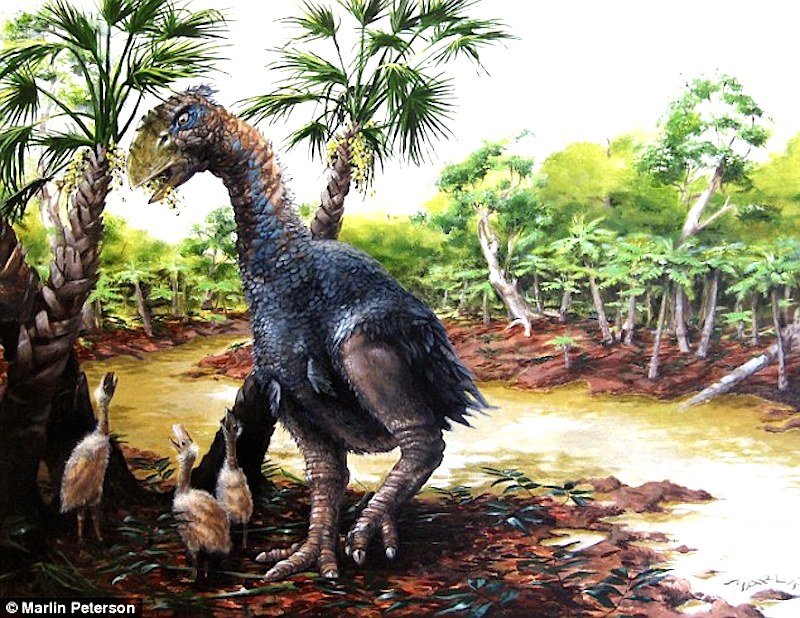
Discovered in the 1970s, this is the first evidence suggesting this species exists above the Arctic Circle. The fossil is a match with the toe bones discovered in Wyoming along side other remnants belonging to the prehistoric bird, Gastornis, according to the Chinese Academy of Sciences in Beijing and the University of Colorado Boulder. The exotic bird is believed to have weighed several hundred pounds with a head the size of a horse's.
'The Gastornis material reported from Ellesmere Island is the northernmost record of that taxon in North America,' reads the study published in journal Nature. 'Some galloanserine birds today (such as Ruffed Grouse, Spruce Grouse, Sharp-tailed Grouse, Willow Ptarmigan, and Rock Ptarmigan) are Arctic residents, and even some waterfowl winter above the Arctic Circle.'
Originally thought to be a fearsome carnivore, recent research indicates Gastornis probably was a vegan, using its huge beak to tear at foliage, nuts, seeds and hard fruit. Remnants of the bird have been discovered in Europe and Asia but never this far north. 'We knew there were a few bird fossils from up there, but we also knew they were extremely rare,' said CU-Boulder Associate Professor Jaelyn Eberl. 'In addition to the Gastornis bone from Ellesmere, another scientist reported seeing a fossil footprint there, probably from a large flightless bird, although its specific location remains unknown.'
This feathery giant roamed Ellesmere Island during early Eocene Epoch, which at the time was similar to the cypress swamps in the southeast US today. Finding the fossils also suggests the island was home to other warm weathered creatures such as turtles, alligators, primates, tapirs and even large hippo and rhino-like mammals.
While on the hunt for Gastornis, researchers stumbled upon a single fossil humerus, or upper wing bone, that once belonged to another Ellesmere Island bird from the same period. Named Presbyornis, it was similar to birds in today's duck, goose and swan family but with long, flamingo-like legs. And unlike Gastornis, Presbyornis could fly. Stidham compared casts of Presbyornis bones excavated in ancient Wyoming to the single bone from Ellesmere Island, including all of the marks for muscle attachments.
'I couldn't tell the Wyoming specimens from the Ellesmere specimen, even though it was found roughly 4,000 kilometers (2,500 miles) to the north,' said Professor Thomas Stidham of the Chinese Academy of Sciences in Beijing.
Ellesmere was also once booming with a diverse selection of plants and animals because, just as the island spends months in darkness today the same happened 50 million years ago. It is not clear is Presbyornis migrated north to Ellesmere Island every year or lived there year round.
This study illustrated what life was like on the island some 50 million years ago. [...] [W]hat we know about past warm intervals in the Arctic can give us a much better idea about what to expect in terms of changing plant and animal populations there in the future.'




Some Points:
1) In the above article, 'they', the MSM, are clearly are saying that the earth has long undergone SIGNIFICANT "climate changes" {which is one of countless statements by the MSM which puts the lie to their KNOWINGLY FALSE claims of
- "Global Warming"*;
- Earth's Weather being significantly affected/caused by "humans and too many SUV's, et al, ad inf."**
- That Earth's weather and adverse events (e.g., earthquakes), happen on a gradual and never in a catastrophic manner.
2) They do NOT point that out, however. just HOW it is that if our Earth is so much and ONLY changing gradually how it was that about 12K years ago, Mammoths were wiped out and are found in Siberia and Alaska with fresh Dandelion Greens in their stomachs which can not grow in arctic cold weather. (Can anyone say "polar shift" - and NOT JUST MAGNETIC!) See, in part, Velikovsky.
R.C.
* The PTB gambled that the next noticeable variation in climate (as weather is simply an ongoing variation in climate, right?) would be getting warmer. But their guess was wrong like so many weathermen guesses over the years.
But THIS TIME, When it didn't go that way - the PTB then began the tactic of rigging the locations of their data compilers, so as to re-confirm their 'undeniable truth" of the Holocaust - oops, I mean Global Warming - so they began their planting of their 'monitoring devices" in unnaturally warm places (e.g., in front of AC exhaust ducts) to rig the incoming data, but that STILL wasn't enough so they had to also get their statisticians and weathermen to play with the numbers (a/k/a, "lies, damned lies, and statistics;" AND "figures don't lie, but liars figure,") - and they got busted, even by the MSM! on their lies and its obvious Globalist agenda.
(If the people had a real say in things, that would have had significant consequences adverse to the PTB's obvious 'plan.' However, because we do not have a real say, it was just another speed bump of truth as a casualty on this PTB's Highway to HELL - for us and our progeny - but not theirs, - as they see it.)
Weather forecasters have always been held in quite low esteem - and nowadays quite rightly - by saying what they THINK their audience wants to hear, -just like a torture victims also do - even when they know it's a flat out lie.
I think the occupations with the lowest trustworthiness,. starting at the worst, still remain:
1. Used Car Salesmen;
2. Attorneys;
3. Weathermen.
**(Not including the PTB's SUV's, of course - they 'need' them more because 'they' need to be 'protected' from attacks from those evil T-Word Types. Why? Because it is they - the PTB! - who are actually "defending' OUR freedom and we we be helpless without them and their attempted and successful assassinations of Andrew Jackson, JFK et al. (Assad & Putin, WATCH YOUR ASSES!);
Also, since it's obviously getting colder, why aren't they pitching how we should increase carbon dioxide emissions? You know why.
RC